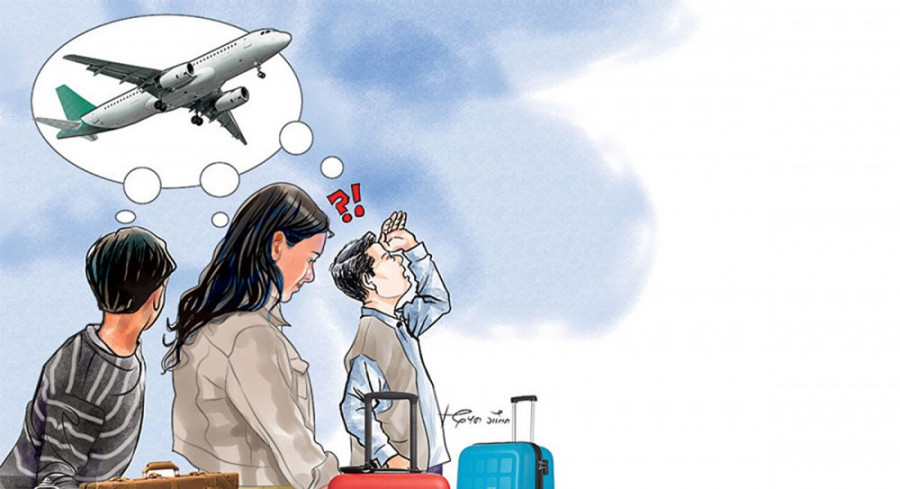Columns
A hub for higher education
To this end, what Nepal needs is robust infrastructure and strong industry connections.
Roshee Lamichhane
Educators and policymakers in Nepal are worried by the dwindling number of students in Nepali higher education institutions. Against such a backdrop, can we still imagine turning Nepal into a hub for higher education in the near future? To become a higher education hub, a country needs a comprehensive education strategy encompassing the establishment of institutions of eminence, the building of infrastructure and the promotion of international collaboration.
Thailand had 4,343 international students in 2002. By 2022, the number had swelled to 34,202. Of them, 21,419 are Chinese. This is nearly an eight-fold increase over 20 years. Thailand’s first Long-Range Plan for Higher Educational Development (1990-2004) is considered largely successful as it emphasised the internationalisation and regionalisation of higher education. Thailand made a strategic move to attract international students, mainly Chinese, to compensate for the low enrolment of Thai students in higher education due to a sharp decline in births. Universities in Thailand provide international courses in English and also some courses in Chinese targeted specifically at Chinese students.
Survey result
A quick dip-stick survey conducted among international students studying in Thailand by this author suggested that the majority of them find the country comparatively inexpensive and safer besides having a good environment. The ease of visa processing and the provision of scholarship opportunities were other plus points. Well-known as a popular tourist destination, Thailand is building an image as the Silicon Valley of Southeast Asia, mostly due to its world-class infrastructure and major developments in IT.
Yet another example that can be cited here is India, which has several initiatives and policies in place to promote higher education and attract international students. Among others, the Study in India Programme that was launched in 2018 aimed to attract foreign students by providing scholarships and fee waivers. Likewise, the New Education Policy 2020 also has policies for higher education development through means such as collaboration, partnership and twinning arrangements with international universities. Alongside this, the National Institutions Ranking Framework was introduced to rank higher educational institutes. Institutions that have performed well in the rankings have gained international recognition and visibility, which help to attract international students and faculty.
Similarly, the number of international students in Malaysia has more than doubled from 80,750 in 2009 to 170,898 in 2019. Adequate measures as cited in the country’s Higher Education Blueprint (2015-25) were taken up to promote the nation as an education hub of eminence. In China, too, the number of international students doubled from 238,184 in 2009 to 492,185 in 2018.
Several factors have contributed to making countries like China, India, Japan, South Korea, Singapore and Malaysia higher education hubs in the region. Ensuring quality education at affordable cost remains one of the common factors among these nations. Students facing severe financial constraints receive substantial financial support. Most of the countries have also been able to provide favourable work visa options after graduation, which has acted as an additional incentive.
Twelve-year roadmap
Taking a cue from the examples cited above, the government of Nepal and its policymakers need to carve out a higher education blueprint for the next decade to double the enrolment of foreign students. Making the nation a higher education hub requires state-of-the-art infrastructure for teaching and research activities besides strong industry connections and collaborations for students to apply their knowledge in real-world settings. Moreover, such higher education institutions should act as a dynamic place for life-long learning and engagement pursuits. Only when all these mechanisms are put in place can Nepal be promoted as a hub for higher education.
This definitely calls for pragmatic policies that prioritise the quality of education together with research and internalisation. Given the existing number of higher education institutions in Nepal, a robust framework alone can make it an education hub of some reckoning in parameters such as teaching, learning, research and overall institutional performance. Once Nepali higher education institutions earn their recognition, they can build and command a modicum of credibility to be able to attract international students.
Focusing on areas where Nepal has a competitive advantage over other nations is the need of the hour. The government also needs to increase its overall education budget, which earmarks the lion's share for higher education with emphasis on research and development activities. To be able to target and attract students from overseas, Nepal can design budget-friendly courses that impart knowledge in disciplines such as Yoga and Well-Being, Traditional Heritage and Culture, and Arts and Crafts, or courses in Glaciology, where Nepal has situational and historical advantages. Attracting both domestic and international students into such niche programmes must be top priority. If Nepali students do not trust and patronise their own programmes, it becomes challenging to garner support from international bodies and make Nepal a destination for international students.
Building additional infrastructure and improving the existing ones becomes a prerequisite in all these endeavours. Ease in processing and obtaining a visa has to be assured for international faculty and students. A stable government alone can lend consistency and predictability to its policies and other initiatives to invite and encourage successful collaboration with international universities. Finally, having a progressive policy framework with long-term vision will help Nepal to fulfil its cherished goal of becoming a hub for higher education.




 9.12°C Kathmandu
9.12°C Kathmandu.jpg)













%20(1).jpg&w=300&height=200)

